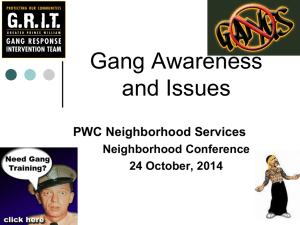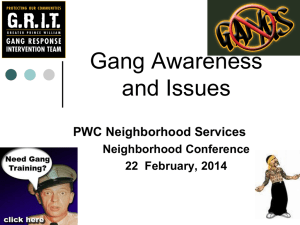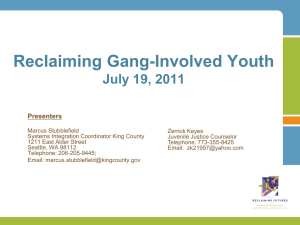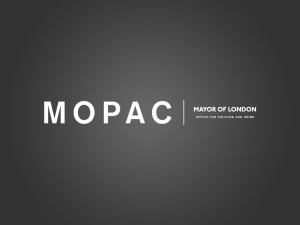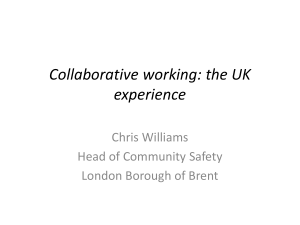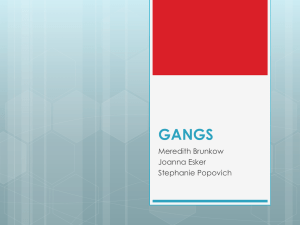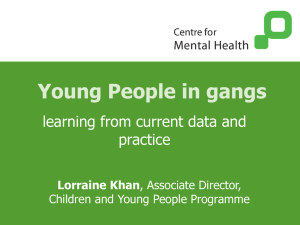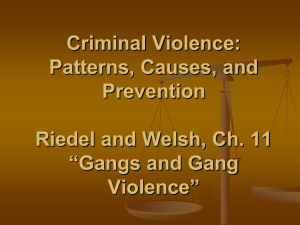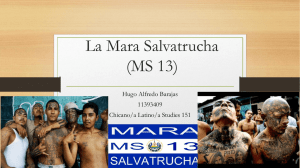Gangs of El Salvador
advertisement
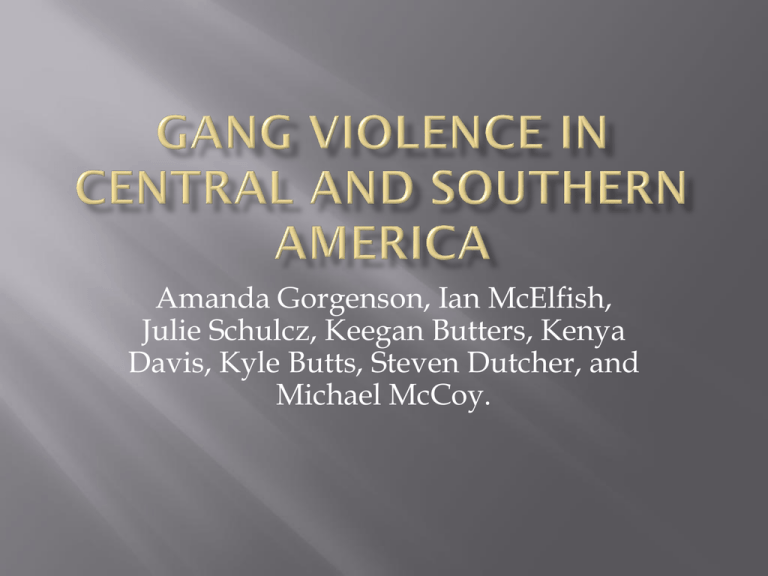
Amanda Gorgenson, Ian McElfish, Julie Schulcz, Keegan Butters, Kenya Davis, Kyle Butts, Steven Dutcher, and Michael McCoy. El Salvador (meaning “The Savior” in Spanish): Population: 7.2 million people ~90% Mestizo (European/Indigenous heritage) San Salvador Capital/Largest City Average of 11 murders a day Large corruption problem within government and with police of the country San Salvador government vs. Farabundo Martí National Liberation Front (FMLN). Left a violent impact on the youth that were left behind from parents who fled El Salvador at the beginning of the Civil War War was in the context of the cold war Fight against communism 75,000 killed Approx. 700,000 refugees fled to U.S. MS-13 MS-13 (Mara-Salvatrucha 13) › “Mara” (meaning “gang” in Spanish) “Salvatrucha” (term used to honor Salvadoran peasants trained as guerilla fighters) 13 (“trece” Spanish for 13) › › › Honors the Mexican Mafia signifying the thirteenth letter of the alphabet “M” Created in Los Angeles during 1980’s High propensity for violence Initiation Kill a member of the 18’s 13 count beat in “uno, dos, tres…” May last longer than 13 seconds depending on how well you are liked by the gang Sexed In (women only) › Biggest and fastest growing gang on the planet 18th Street Gang 18th Street Gang (Barrio 18) › Gang created in Los Angeles in 1959 › Extremely Violent › Rivalry between 18’s and MS-13 › Initiation Kill a member of MS-13 18 count beat in Women no longer allowed to be initiated in as new recruits Outnumbered by MS-13 ORIGIN Developed to protect refugees of El Salvador from other gangs already established in Los Angeles. Gangs based off racial prejudices These racial tensions were present amongst all races of newly arrived immigrants New immigration laws in US 1990’s New laws led to deportation of illegal immigrants for even minor convictions in the US This return of gang members gave way to a new platform for the gangs to recruit new members BACK HOME (POST 1992) The deportation of these gang members led to a newly established gang population in the war-torn El Salvadoran streets The tensions between MS-13 and the 18’s are so strong that each member obligated to kill any and all opposing gang members that they encounter on or off of their territories known as “clickas” or “barrios” The games are organized in a decentralized fashion of “clickas” Insubordination to fulfill missions of robbing or killing can result in brutal beating of 13 or 18 counts respectively Also grounds to be killed by ones own gang MS-13/18 STREET GANG Extortion and Racketeering of local businesses Offer protection in exchange for “taxes” Drug Trafficking Cocaine Crack Cocaine Powder Cocaine HCL Methamphetamine Pseudoephedrine Ephedrine Marijuana Heroin Prostitution Fraud Counterfeiting Identity Documentation Forgery Human trafficking Kidnapping Murder Rape Gang member are not a permitted to sell drugs for personal usage to their own members they commonly refer to as “homeboys”. Reason being that drug addicts may wander into enemies territory looking for more drugs and get killed Disobedience to this can result in gang beatings of 13 or 18 counts respectively Gang members in the United States are given orders in regards to killings or other gang related businesses from higher ranking members living in El Salvador MS-13 •Darker shades of red represent stronger presence within region •Growing presence in regions throughout the world •Considered world’s fastest growing gang •Approx. 30,000-40,000 members •22,00 members in El Salvador •Individual sets are controlled by shotcallers who collect “taxes” from both their businesses and other members of the gang with lower rankings. MS-13 (cont.) •Gang members of MS-13 commonly have tattoos all over their bodies representing their loyalty to the gang EIGHTEENTH STREET GANG Approx. 12,000 members in El Salvador Growing international gang with known presence in 32 US states 18th Street has a structure made up of “ranfla” (national leaders), “runers” (leaders with no tattoos, strong discipline, and the responsibility for committing homicides, and trafficking drugs and weapons), and missionaries (clickas gang members). 18th Street Gang •18’s are also easily identified by gang tattoos •Tattoos enable them to represent their gang for life Gangs of El Salvador MS-13 and 18’s have women in the gangs that are just as active as the men •New gang rules imposed by top 18th street gang leaders state that women are not allowed to be initiated as new recruits anymore •Both WORLD PRESENCE MS-13 and the 18’s can be found in almost all Central American countries, and within a majority of the United States Extremely violent and willing to kill anyone perceived as either a threat or rival gang member Rise in gangs, violence & drug trafficking began in the early 1980s Neglect of the poor neighborhoods during Brazils dictatorship period lead to the rise of gangs Brazilian government used a form of isolation and exclusion of favelas from major cities Many people turned to gangs for protection Drug trafficking helped many gangs rise to power Police have more difficulty entering poor neighborhoods due to the rise in gangs and the distrust in law enforcement Corrupt law officials helped strengthen the dominance of gangs Today inadequate governmental officials, a lack of resources to address the socioeconomic problems and a insufficient law enforcement force allow gangs to still be around and in charge Amigos dos Amigos Comando Vermelho (Red Command) Tarceiro Comando Puro (Pure Third Command) Primeiro Comando da Capital (First Capital Command) Capixaba Mafia Grew out of conflict between the Red Command and the Pure Third Command Controls North and West zones of Rio de Janeiro (Rocinha) Drugs critical source of power & wealth Largest and oldest organized gang in Brazil Established in Rio de Janeiro in 1970's Major trafficker of weapons and drugs Began as a gang in Cândido Mendes prison Had very strict code of conduct for members Punishments (such as death) for violators Maintain control this way Originally composed of members of the Falange Vermelha (Red Phalanx) This militant group was strong in it’s fight against the Brazilian military dictatorship (1964 to 1985) Originally founded by dissidents of the Red Command • therefore these two gangs are major rivals Fighting between gangs often occurs for supremacy in the slums and throughout the extensive prison system in Brazil 360,000 prisoners (4th largest in the world) 922 prisons Founded August 31, 1993, in Taubate Prison in Sao Paulo Began as prison gang, but transformed into a terrorist criminal organization Members utilize a “baptism” ritual as means of induction into the gang, similar to the Mafia organizations within the U.S. Goals of the PCC were outlined in the group's sixteen point manifesto written in 1993 To fight injustice and oppression in the prison system To maintain strict discipline among members To expand beyond Sao Paulo prisons to national spotlight Criminal organization from the Espírito Santo state of Brazil A person born in this state is known as a “Capixaba” which literally translates to “Holy Spirit” Specializes generally in moneylaundering endeavors People are terrified to walk the streets at any time Neighborhoods are marked with violence and violation of human rights Violence in the favelas increases when police try to take action There has been a crackdown on corrupt officers in the recent months More than 33 officers arrested The clean up operation, taken place w/ the government forces Equally severe law enforcement strategy directly targeting drug gangs Government seeking to re-establish control over the urban slums by sending in special operations force Government improving living conditions of slums so people can stop depending on gangs Dealing with financial pressures from the state and bribes and threats from drug traffickers make it extremely difficult for leaders to take stand against the local gangs Government is making progress in clearing Brazil of its gangs Rid over 3 dozen communities in Rio de Janeiro of its drug gangs and installed permanent police forces In order to reduce corrupt officials, many are purposely recruited right out of the police academy (before any bribes can be made) Many Brazilians are contributing to a social movement for political change Brazilian artist are coming up with compositions to support Brazils movement to eliminate gangs and drug trafficking Raise awareness of socioeconomic issues of their country in their demand for change I. II. III. IV. V. VI. Introduction Gangs of Peru: Overview History and Formation of Peruvian Gangs Peru’s Political and Socioeconomic Conditions Current Events on Peruvian Gangs Conclusion Introduction There are hundreds of Peruvian gangs that have thousands of members affiliated to them. Most Peruvian gangs are found within the regions of Peru’s major cities: Lima, Huancayo, Trujillo, Arequipa, Cusco, Chimbote, Chiclayo, Iquitos, and Huamanga. Lima is the capital and largest city of Peru, so the vast majority of Peruvian gangs will migrate and establish themselves here. Peruvian gangs engage in all kinds of criminal activities such as drug, human and weapon trafficking, money laundering, terrorism, violence, and guerilla warfare. Not a whole lot of research is done on Peruvian gangs in particular, so research and data can be difficult to find. Police have difficulty obtaining data and statistics for many Peruvian gangs since there’s so many of them out there. Only the larger, more notorious gangs are noticed by police and civilians. Peruvian gangs vary from guerilla organizations, to street gangs, to youthoriented gangs. Street gang members typically range from 13-24 years of age, while youth-oriented gangs mostly involve children and teens 8-16 years old. Initiation into Peruvian gangs include the same criteria that most other gangs follow across the globe. This includes blood-in, beat-in, jump-in, assault, murder, rape, and blood-out. Street Level – Los Pandillas, Malditos de Castilla, Bandas, Los Alamos, Latin Kings, Los Diablos, Cirujanos, La Muralla, and Los Pishtakos are some of the more famous Peruvian Street gangs. Youth Gangs (Street Children) - Pájaro frutero, and pirañitas. These particular gangs work in packs by stalking their prey and mugging them in groups. The victims become overwhelmed and end up losing anything in their possession. Guatemala has long since been known as one of the most violent countries in the region of Latin America, as well as the world. The Homicide rate in 2008 was 48 murders per 100,000 people, in contrast with the 5.7 murders per 100,000 people in the United States. The most widely accepted reason for the abundance of gangs throughout Guatemala is the United States. In the 1970’s and 80’s many family’s fled to the United States to escaped a war torn country. Once there, many of the children got involved in gangs. The United States then started to deport Guatemalans, many of which thrived on the gang culture in the United States, more specifically Los Angeles. Because many were unable to speak Spanish or adapt to the new life style, they set up new gangs in Guatemala which have evolved into new strains and spilled over to more countries. Most gangs make their money by self-styled taxes, in which they levy from bus-drivers, shopkeepers, homeowners, and young neighborhood girls. They are also involved in robbery, extortion, drug dealing, human trafficking, and wars with rival gangs On average, gang members are initiated between the years of 14 and 15. Estimates cite that there are anywhere from 8,000 to 14,000 gang members throughout the country. The two largest gangs prevalent in Guatemala are the Mara Slavatrucha (MS-13) and the Barrio 18 (18th street gang). The 18th street gang account for 15% of all gang members throughout the country. MS-13 makes up 95 percent of the gang members within the country. Both gangs were originally started in Los Angeles. In 2008, 229 bus drivers, and taxi drivers were killed by gang members for not paying extortion costs. More recently, due to Mexico’s war on drugs, many Mexican gangs have crossed into Guatemala. http://www.youtube.com/watch?v=TZrlJYZ6kNk&fe ature=fvwrel One particular drug gang, known as Los Zetas have crossed into Guatemala ravaging the city and the jungle. This gang is known as “a group of Mexican military deserters…who have kidnapped, tortured and murdered—including beheadings of law enforcement officials, innocent citizens, informants and rival drug gangs. In 2004, American and Guatemalan diplomats created a prevention program called “Tell it to Waldemar” This program would create a corruption free police force, crime information system. It would also create an anonymous system for crime reporting. To increase safety measures for public transportation, the government recently implemented a new system where passengers have tickets to board, and the drivers carry no cash with them. Recently, the President has declared a state of siege, and is escalating a war against drug traffickers, more specifically against the Los Zetas. The state of siege curtails citizen liberties and allows the military to order anyone suspected of conspiring against the government to be arrested ad imprisoned without warrant The campaign to eradicate the gangs is known as “limpieza social”, or social cleansing. This type of social cleansing has become so prevalent in Guatemala that many young people say it’s become dangerous to even look like you belong to a gang. Many gang members have also eradicated the use of colors, symbols and tattoos to identify them within the gang. Currently, the gang causing most problems within the country is Los Zetas. Recently, they stormed a remote jungle ranch and killed 27 people, beheading 25 of them. This gangs expanded into Guatemala after murdering a local drug boss. They have recruited many Guatemalan soldiers, and many poor, indigenous citizens have also signed up. Their priority is to move large scale drugs from Colombia, to Mexico and eventually to the United States. It is very important to regain control of Guatemala from the gangs, if it ever wants to become a prosperous country. “Guatemala is a very violent country. This, sadly, is our cultural response: an eye for an eye.” – longtime Human Rights monitor. Los Paisas begins with the paramilitary and their offer from the Colombian Government called the Justice and Peace Law. The Justice and Peace Law allows paramilitary soldiers to lay down their weapons for no serious punishment, even though they have taken thousands of Colombian lives and helped in drug trafficking. The goal of the Colombian Government was to demobilize the Paramilitary that was originally created in the 1960’s to help with human right violations. •Highlighted areas are where Los Pasias can be found. •The gang can is now considered an independent drug trafficking organization. •http://www.youtube.com/watch? v=C3X6SFoCNBc Due to their Northern location by the Atlantic and Pacific Ocean there are rival gangs fighting for the same territory due to excellent coca growing and trafficking location. These rival gangs consist of Los Rastrojos, Los Urabeños and Los Aguilas Negras. Due to rival gangs being a close facility homicide rates have increased in northern colombia Los Paisas relies highly on recruiting young members and have them murder enemies as well as Los Paisas family members to instill fear. Cesar Augusto Torres Lujan was the leader of Los Paisas until the Colombian Police killed him in 2010. Even though the death of Cesar Augusto Torres Lujan Los Paisas is still an active gang in Colombia. The most dangerous gang in Venezuela •The Tupamaro or Tupas are a Venezuelan “gang” based out the countries capitol city of Caracas. •The Tupas blur the lines between street gang and terrorist organization, they resemble more of a hybrid between street gang and a vigilante militia. •They are known to be politically connected to some of the most powerful politicians in Venezuela. •Tupas show many similarities to groups like Hamas in Lebanon and Palestine, or the KKK in the early 20th Century Venezuela’s Capitol is the birthplace of the Tupas and continues to serve as the gangs home. The name Tuparmos comes from a Uruguayan communist group of the same name, who were forced into exile in the 1970‘s. Some fled to the neighborhood of “23 de Enero” A ghetto in Caracas. The Venezuelan Tupas emergence as an identifiable group took place during the 1980’s when attacks on drug dealers began in “23 de Enero“. The gang targets youth who have grown up in or near “23 de Enero” many of whom have family ties with the area or the Tupas themselves. Some members join the Tupas because the gang’s influence and political ties can all but guarantee a government subsidized employment. Many other join the Tupamaro simply for protection, Caracas is one of the world most dangerous cities with a murder rate twice that in Iraq. In 2005 the Tupas even went as far to organize a large hip-hop concert near “23 de Enero” free to the public. The Tupas conduct criminal activities much like extortion, protection rackets, prostitution, and kidnapping. They also act as an vigilante goon squad on behalf of their political patrons. In 2002 the Tupas were blamed for attacks carried out on police with high powered rifles, to “persuade” the Supreme Court to rule in again some of their opponents in a rebellion trial. Tupamaros were also responsible a 2006 attack on American ambassador William Brownfield, there men on motorbikes attempted to surround his car, and light it on fire. Scores of murders are attributed to the Tupas, everyone from rival gang members, to people who simply refuse to pay “rent” for living in the neighborhood. As the gang grows it has begun to move into assassinations, mainly of rival political threats. Tupas are of course constantly battling police in their Caracas slums The gang is also often at odds with other leftist groups such as the CRA, Red Flags, and the Accion Democratia As well as other rival street gangs Hugo Chavez allied himself with the Tupas during his incarceration for his failed coup in 1992. The Tupas strongest ally, the Fifth Republic Movement, from 1997 - 2008 this was the political party of Hugo Chavez A lot of their support also comes from the Communist Party of Venezuela In 2008 the Fifth Republic Movement, merged with several smaller leftist groups as well as politically connected members of the Tupas to create the United Socialist Party of Venezuela, headed by Hugo Chavez. The Tupamaro are an armed and politically active leftist group who control much of the western side of Caracas. The Tupa also enjoy the benefits that come from being very well connected, bordering on state sponsorship The earlier Mexico gangs were for the most part located in border towns close to the United States, where drug addicts, prostitutes, bootleggers and a lot of people involved with extortion resided. Mexican drug cartels expanded their reach first south rather than immediately into the United States: down throughout Central and South America Columbia is basically controlled by many South American gangs, but they must do business with the Mexican cartels to transport drugs to the United States or anywhere else north. The Northern Mexico gangs hold the most power because their location is the most important geographical region for trafficking. The most powerful drug cartels in Mexico where the Arellano Felix gang of Tijuana, the Juarez organization in Ciudad Juarez, the West Coastbased Sinaloa consortium and the Reynosa based Gulf Cartel, all because of their location . In order for gangs or cartels to transport their drugs to the United States they had to deal with these Mexican cartels. Cartels would constantly battle it out over the routes to the United States, especially in the late 1960s and early 1970s when cocaine and marijuana in the United States became extremely desired In 2007, Mexico's police stepped up enforcement, crushing many gang cells responsible for 2,000 murders in 2006 . Police and gangs were battling it out in gang territory, but this violence also spread into public areas causing a massive uproar from the public. Disney is one of the world’s largest businesses, and their cruise ships as well as other companies refuse to make any stops to the former popular Mazatlan, because of known gang violence. Mexico's street gangs are very similar to the United States street gangs because they both have similar intentions and goals of robbery, violence, theft, drug sales, drug abuse, and of course extortion. Although Mexico’s street gangs and United States street gangs are very similar, they also have some major differences. The most profound difference between the two types of gangs would be that many of Mexico’s street gangs are controlled by cartels and do whatever the drug cartels tell them to. Street gangs in the United States are typically independent. More than 1,000 kidnappings were carried out in 2008. Mexican kidnap gangs have armored vehicles that are bulletproof, technology that can jam cameras, and a crew with snipers, spies, or whatever it takes to make a clean kidnap Some of the ones being kidnapped may be rich kids and the gang may want a large sum of money from the family, but others are extremely high profile and the one who the gang wants to kidnap may have body guards and or other security personnel to prevent a kidnapping or murder from happening. The past five years the Mexican gang violence has seemed to unfortunately increase dramatically. The rivalry for power and for territorial grounds has caused crazy wars and battles between these gangs and police as well. This huge problem of gang and police violence has made its way into the United States. http://www.youtube.com/ watch?v=4-qAuaj6j4&feature=relmfu Recent news is the stealing of oil in Mexico by Mexican drug cartels. This has been a problem for quite some time, but it was recently became a rapidly spreading theft. The cartels have been tapping into the country’s pipelines to steal as much as $715 million in oil annually The gangs sell the stolen fuel to corrupt manufacturers or trucking firms, or sell it to foreign refiners for a much lower price. The number of pipeline taps has increased since 2004, from 102 then to 462 last year. They are fixing the oil pipeline where drug cartels were getting some of their oil from. Gangs in Ecuador started to become popular in the 1980s. Quito and Guayaquil are the two providences with the most gang activity Guayaquil is known to be the most dangerous city in Ecuador Recently, the number of gang members has risen due to qualitative and quantitative reasons. There has been an increasing number of young people in Ecuador involved in gangs Coming and going of members is highly regulated Many members have connections to the government (mostly those responsible for security) which makes carrying out crimes easier Quito Pandillas: local urban youth gangs Ciudades Naciones (Latin Kings): organized national youth gangs Guayaquil Naciones (Latin Kings) Pumas Rusos Chiquicha Cazadores Fantasmas Contras Duenos de la Calle Ecuador has a population of about 14.3 million since 2010 About 1,000 gangs in Gauyaquil alone In 2002 there were about 65,00 known youth involved in street gangs in Ecuador The average age of youth joining gangs is 13 There is an average of 18.33 murders per 100,000 population The most important institution created to help the government of Ecuador fight gangs is the SER PAZ foundation, an international foundation that specializes in problems of youth and violence From that foundation came a project called the Peace Neighborhood (Barrio de Paz) that has been a process in the city of Guayaquil since 2005. The project is an agreement between five gangs and the rest of the community for coexistence in 49 blocks of Guayaquil First step is handing over weapons, then setting up communities for former gang members . Not everyone complies but there has been a 60% reduction of crime rate in the Peace Neighborhood

